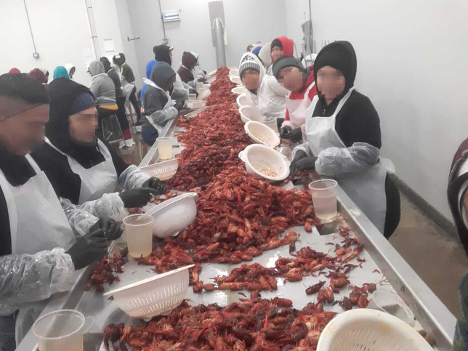August 3, 2020
Know the measures seafood processing workers should take during the pandemic

Several governmental agencies in the United States have developed a guide on how to protect seafood processing plant workers.
Even though seafood processing workers in this industry are not exposed to COVID-19 through the fish and seafood products they handle, their working environments–including processing stations and other areas of the factory where they are in close contact with coworkers and supervisors–may increase the risk of contracting the virus.
Among the factors that increase the risk of getting coronavirus at the workplace are:
The distance between seafood processing workers who often work near others in cutting, packing, quality control or on the production line.
The amount of time workers are in contact with each other (e.g., more than 8 to 16 hours per shift).
The type of contact: while a person carrying the virus coughing, sneezing or talking most clearly risks exposing coworkers to infection, it is possible that exposure can occur through contact with contaminated surfaces or objects like tools, work stations or resting areas.
Seafood processing employers should create a plan for assessing and controlling COVID-19. This plan should include measures to prevent and detect cases and to respond to infections. Workers should know who is responsible for carrying out the plan in the workplace and who to go to in case of any concerns about the virus.
The CDC recommends using cloth face masks as a preventative measure in addition to staying at least 6 feet away from others. Employers should ensure that cloth face masks are being used adequately in the workplace:
The mask should cover the nose and mouth and should fit snugly and comfortably on the face.
It is best to have multi-layered masks that are washable and can be left to dry before re-wearing.
As necessary, the employer should provide clean face masks
Employers and workers should keep the following in mind:
Frequently clean and disinfect all common areas: work areas living spaces, dining rooms, kitchens and bathrooms
Ensure proper air flow with appropriate air filtration systems for indoor areas
Limit the amount of people in common spaces
Do not share plates, glasses, table settings, cups or cooking utensils. Reusable utensils and dishes should be handled with gloves and washed with hot water and soap
Use gloves to throw away and take out the trash
Wash work clothes and store them in an appropriate place
With respect to social distancing in bedrooms or dormitories: It is recommendable to space beds at a distance of at least 2 meters (6 feet) between beds, to add physical barriers, like flexible plastic screens, and to limit or eliminate the use of bunk beds.
The risks of contagion are reduced significantly by performing these preventative measures. By not taking them, you put yourself and those around you at risk. If there is a threat of contagion from COVID-19 among your coworkers during this time and your employer does not follow the recommendations to prevent the introduction of COVID-19 in your workplace, you can file a complaint with the Occupational Safety and Health Administration (OSHA) - 800-321-6742.
For more information or for help, please contact CDM:
Free within the US: 1.855.234.9699
Free within Mexico: 800 590 1773
Email: [email protected]
This guide was developed by the Center for Disease Control (CDC) and the Occupational Safety and Health Administration (OSHA) in collaboration with the Food and Drug Administration (FDA).
